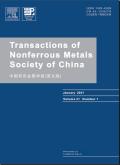Influence of process parameters on microstructure and properties of Cu−Cr−Nb−Y alloy manufactured by laser powder bed fusion
IF 4.7
1区 材料科学
Q1 METALLURGY & METALLURGICAL ENGINEERING
Transactions of Nonferrous Metals Society of China
Pub Date : 2025-04-01
DOI:10.1016/S1003-6326(24)66744-0
引用次数: 0
Abstract
A novel Cu−4.8Cr−2.2Nb−0.15Y (at.%) alloy was fabricated by employing the laser powder bed fusion with different processing parameters. The influence of laser power (P), scanning speed (v), and laser linear energy density (El) on the defects, melt pool morphology, microstructure, and properties of the alloy was systematically investigated. The results show that the optimized process parameters for preparing Cu−Cr−Nb−Y alloy with relative density over 99.5% are P=300−350 W and v=650−800 mm/s, corresponding to El=0.375−0.538 J/mm. When El < 0.3 J/mm, increasing P or decreasing v can enhance the continuity and size of the melt pool, reduce the lack-of-fusion defects, and increase the relative density. However, excessively high El leads to a deeper melt pool, more keyholes, and reduced relative density. The grain size of the as-built Cu−Cr−Nb−Y alloy shows a bimodal distribution, with fine grains at the center and coarse grains at the edge of the melt pool. Increasing P or decreasing v increases the average grain size and 〈110〉 texture intensity. The alloy fabricated with P=350 W and v=800 mm/s displays the highest relative density of 99.82%. The yield strength, tensile strength, and elongation are (443±5) MPa, (699±4) MPa, and (17.1±0.7)%, respectively.
工艺参数对激光粉末床熔合Cu−Cr−Nb−Y合金组织和性能的影响
采用不同工艺参数的激光粉末床熔合法制备了Cu−4.8Cr−2.2Nb−0.15Y (at.%)合金。系统地研究了激光功率(P)、扫描速度(v)和激光线能量密度(El)对合金缺陷、熔池形貌、显微组织和性能的影响。结果表明,制备Cu - Cr - Nb - Y合金的最佳工艺参数为P=300 ~ 350 W, v=650 ~ 800 mm/s,对应El=0.375 ~ 0.538 J/mm。当El <;0.3 J/mm时,增大P或减小v均能增强熔池的连续性和尺寸,减少未熔合缺陷,提高相对密度。然而,过高的El会导致熔池更深,钥匙孔更多,相对密度降低。铸态Cu−Cr−Nb−Y合金的晶粒尺寸呈中心细晶粒、边缘粗晶粒的双峰型分布。增大P或减小v会增大平均晶粒尺寸和< 110 >织构强度。当P=350 W, v=800 mm/s时,合金的相对密度最高,达到99.82%。屈服强度为(443±5)MPa,抗拉强度为(699±4)MPa,延伸率为(17.1±0.7)%。
本文章由计算机程序翻译,如有差异,请以英文原文为准。
求助全文
约1分钟内获得全文
求助全文
来源期刊
CiteScore
7.40
自引率
17.80%
发文量
8456
审稿时长
3.6 months
期刊介绍:
The Transactions of Nonferrous Metals Society of China (Trans. Nonferrous Met. Soc. China), founded in 1991 and sponsored by The Nonferrous Metals Society of China, is published monthly now and mainly contains reports of original research which reflect the new progresses in the field of nonferrous metals science and technology, including mineral processing, extraction metallurgy, metallic materials and heat treatments, metal working, physical metallurgy, powder metallurgy, with the emphasis on fundamental science. It is the unique preeminent publication in English for scientists, engineers, under/post-graduates on the field of nonferrous metals industry. This journal is covered by many famous abstract/index systems and databases such as SCI Expanded, Ei Compendex Plus, INSPEC, CA, METADEX, AJ and JICST.

 求助内容:
求助内容: 应助结果提醒方式:
应助结果提醒方式:


